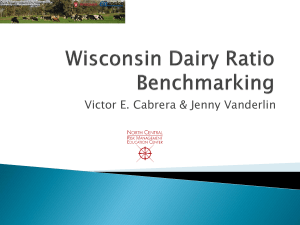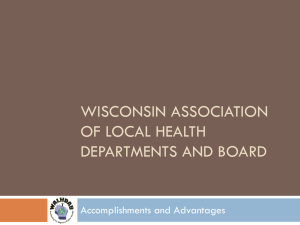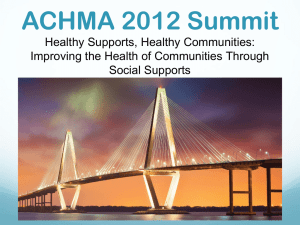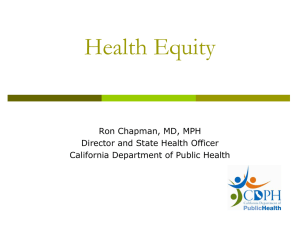Health Equity Concerns: Social Determinants in Public Health
advertisement
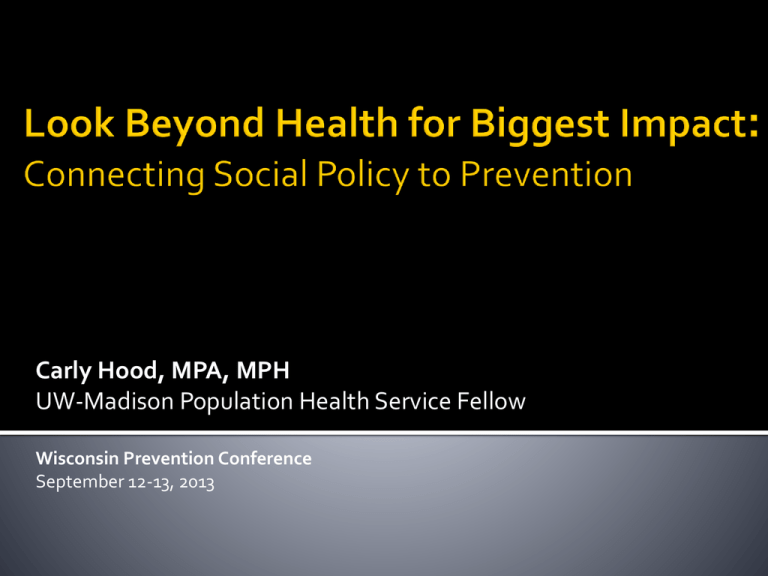
Carly Hood, MPA, MPH UW-Madison Population Health Service Fellow Wisconsin Prevention Conference September 12-13, 2013 Health outcomes overview What impacts health Why health equity matters Support and social programs Public perception Public health models and example project Public health and YOU Questions, thoughts, reflections… True or False? The United States ranks 1st in life expectancy compared to other industrialized countries. False. Which country ranks 1st? Switzerland for males. Japan for females. Source: Milwaukee Health Report 2011 http://www.cuph.org/mhr/2011-milwaukee-health-report.pdf Source: Milwaukee Health Report 2011 http://www.cuph.org/mhr/2011-milwaukee-health-report.pdf Source: OECD Health Data 2009 But only half the battle!!! What impacts health? Doctor Age Income Health behaviors Culture Housing Clinical care Social support Insurance Education Family Neighborhood Social determinants of health Largest impact Structures, policies, systems Community Institutions/Organizations Interpersonal Individual Smallest impact Local, state, federal policies and laws to regulate/support health actions Social networks, norms and standards Rules, regulations, policies and informal structures Family, peers, social networks and associations Knowledge, attitudes, beliefs and behaviors Sources: RWJF-Stable Jobs http://www.rwjf.org/en/blogs/new-public-health/2013/01/stable_jobs_health.html • Access to health promoting goods and services • Psychosocial effects linked with economic resources • Cumulative effects over time and at critical periods. Sources: RWJF 2008, Obstacles to Health Report, Szanton 2005, RWJF-Stable Jobs http://www.rwjf.org/en/blogs/new-public-health/2013/01/stable_jobs_health.html Braveman, Paula. Income Wealth and Health. RWJF Special Issue Brief http://www.rwjf.org/content/dam/farm/reports/issue_briefs/2011/rwjf70448 100% Low income (<$20,000) 90% Middle income ($20,000-$74,999) 80% High income ($75,000+) 70% 60% 50% 40% 30% 20% 6% 10% 0% 36% 13% Fair or poor health 17 58% 37% 26% 71% 67% 69% Physical health not good on any Poor health limited usual activities day during past month on any day during past month Source: Behavioral Risk Factor Survey (BRFS); 2008-2011 landline only dataset Source: RWJF 2012 http://www.rwjf.org/en/blogs/new-public-health/2012/08/better_educationhea.html.html Source: http://www.rwjf.org/content/dam/web-assets/2009/09/education-matters-for-health 50% 45% <High school 40% High school graduate to some college 35% College graduate+ 30% 25% 20% 15% 10% 5% 0% 26% 12% 5% Not currently working Source: Behavioral Risk Factor Survey (BRFS); 2008-2011 landline only dataset • Access to affordable options. • Ability to meet other basic needs. • Privacy and security. • Stability and sense of control. • Toxin-free air and water, injury free structure. • Safe, clean air and water. • Access to public resources: transportation, police force, good schools. • Access to healthy food. • Options for exercise. Source: Commission on Health http://asthmaregionalcouncil.org/uploads/Healthy%20Homes/commissionhousing102008.pdf Wisconsin Homeownership Rates, 2007 80% 73% 70% 60% 50% 40% 40% 30% 20% 10% 0% Whites Minorities Source: DOA http://doa.wi.gov/docview.asp?docid=9263&locid=173 Less mobility More Inequality Associate with Less Generational Mobility Higher inequality Source: Journal of Economic Perspectives, Corak http://pubs.aeaweb.org/doi/pdfplus/10.1257/jep.27.3.79 What grade would YOU give Wisconsin for health disparities? Source: UW Population Health Institute http://uwphi.pophealth.wisc.edu/programs/match/healthiest-state/report-card/2010/index.htm Moral Spillover effects Save money Avoidable/preventable Sources: Woodward and Kawachi, 2000, LaVeist, Gaskin, and Richard, 2009; Dow and Schoeni, 2008 “…the biggest barrier to good health is poverty. I think if we could eliminate childhood poverty we would go a long way to achieving a healthier population.” -CMA President Anna Reid Source: http://healthcaretransformation.ca/report-what-makes-us-sick/ Measure Wisconsin Rank Binge Drinking 50 Public Health Funding 50 Air Pollution 31 Vegetable Consumption 29 Children in Poverty 27 Infant Mortality 27 Personal Income, per capita 25 Source: America’s Health Rankings, 2012. http://www.americashealthrankings.org/WI/2012 Healthiest Wisconsin 2020 Social, economic and education factors that influence health. Health disparities. Healthy People 2020 “Create social and physical environments that promote good health for all.” 5 key determinants. Sources: HW2020 http://www.dhs.wisconsin.gov/hw2020/focusareas/index.htm HP2020 http://healthypeople.gov/2020/about/default.aspx http://www.youtube.com/watch?v=LMpQEM b0Trc How do you think most people feel about government playing a role in people’s health? 2007 Views on Government Priorities for Improving Health Improving social support/networks 15 44 Reducing violence 20 45 21 35 4 16 High priority Improving housing quality 32 48 10 Reducing unemployment 51 Increasing number who finish high school 49 33 Improving access to early childhood programs 47 38 Reducing poverty 34 10 20 30 40 60 70 Not effective/Gov Shouldn't Address 14 3 7 14 50 Low priority 5 5 26 76 0 7 11 64 Medium priority 14 8 35 Providing health insurance to more people 10 31 41 Improving physical environment 5 5 60 Improving health practices 12 80 4 5 90 100 Source: Robert, Stephanie. Public Views on the Determinants of Health, Interventions to Improve Health, and Priorities for Government. Wisconsin Medical Journal . 2007. Volume 107: No 3 Traditional model Equity model Surveillance, healthy behavior promotion Policy development, policy analysis, upstream interventions Home visits, immunization clinics, health education Community capacity building Narrow policy focus (e.g., seat belts, smoking) Social systems, policies, & practices Collaborations: • Health care providers • Social service agencies Collaborations: • Organizations who work on policy and advocacy on social, economic and environmental issues • Community organizers who work on civic engagement • Community planners 5 Modules: Where do we start? Perspectives on framing. Public health history. Root causes. Social justice. Source: www.rootsofhealthinequity.org http://www.youtube.com/watch?feature=pla yer_embedded&v=Btqq1yfk-9g Root causes Social determinants Power Discrimination Sexism Classism Source: Patters, Boston Public Health Commission presentation Policies, institutions, systems Eg: Labor sphere, education sphere, social inclusion, racism/discrimination Health determinants Eg: Income, education, housing, childcare, employment/vocational training, social support Mediators of health E.g: Lack of resources and access, constraints on healthy behaviors, chronic stress Health outcomes & health inequities What Makes Us Healthy What We Spend On Being Healthy Physical environment 10% Clinical care 20% Health behaviors 30% Socioeconomic factors 40% Medical services 88% Other 8% Health behaviors 4% Source: RWJF County Health Rankings Source: Derived from information from the Boston Foundation (June 2007). My work includes health equity because… Degree of Impact I don’t discriminate against anyone I serve vulnerable populations impacted by these disparities I plan my work in a way that ensures it addresses the factors leading to health inequities Source: Patters, Boston Public Health Commission presentation Degree of Impact I don’t discriminate against anyone I serve vulnerable populations impacted by these disparities I plan my work in a way that ensures it addresses the factors leading to health inequities Source: Patters, Boston Public Health Commission presentation 1) Educate public, other professionals, elected officials and the media about what makes a healthy community. 2 ) Advocate for policies that will create healthier communities and invest in interventions that build capacity of communities to engage in local decision making. Health in ALL policies! Letters to the Editor (LTE) Opinion and editorial pieces (Op-Eds) Press releases Media interviews 3) Analyze policies, programs and projects for potential health impacts (HIA). 4) Engage diverse, non-traditional partners in public health work. Examples: Economic policy advocacy groups Transportation groups Business Leaders Education Sector Leaders Community-based Organizations Faith-based Organizations Public Safety Officials Policy makers and elected officials 5) Research social policies and the support of such policies to build evidence base. Division of Public Health leadership and staff Health First Wisconsin staff Minority Health Leadership Council and community partners UW Population Health Institute staff and fellowship community WI Center for Health Equity WI Clearinghouse for Prevention staff WI Minority Health Program staff Presentation graphs: Woolf SH, Aron LY. The US Health Disadvantage Relative to Other High-Income Countries: Findings From a National Research Council/Institute of Medicine Report. JAMA. 2013;309(8):771-772. doi:10.1001/jama.2013.91. World Health Organization Commission on Social Determinants of Health: www.who.int/social_determinants Unnatural Causes: www.unnaturalcauses.org Policy Link: www.policylink.org Wisconsin Center for Health Equity: www.wche.org National Association of City and County Health Officials (NACCHO)—Roots of Health Inequity online course: http://rootsofhealthinequity.org/ UW Madison Population Health Institute: http://uwphi.pophealth.wisc.edu/ Questions? Carly Hood, MPA, MPH UW Madison Population Health Service Fellow Contact: chood@wisc.edu

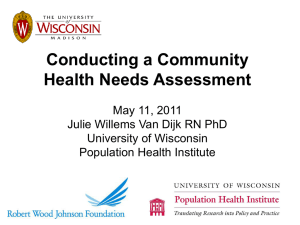
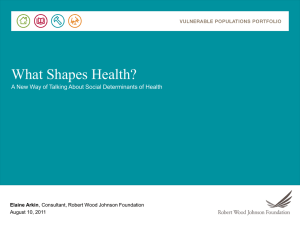

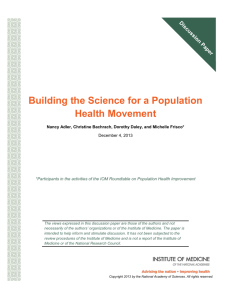
![[Company Name] Certificate of Completion](http://s2.studylib.net/store/data/005402466_1-8a11f4ced01fd5876feee99f8d8e6494-300x300.png)
